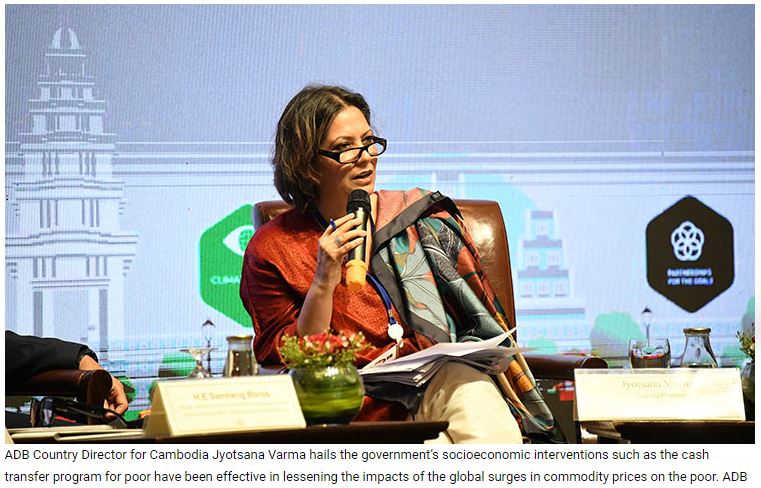ADB re-projects Cambodia’s GDP down for 2023, inflation up for 2022
The Asian Development Bank (ADB) has revised down projection of Cambodia’s Gross Domestic Product Growth to 6.2 percent this time for 2023 from 6.5 percent forecasted earlier as the country’s economy would be affected by weaker global economic growth, according to a news release received by Khmer Times from ADB yesterday.
However, the Asian Development Outlook Update for 2022 shows that the GDP of this Southeast Asian country is expected to grow by 5.3 percent – the same as the rate ADB forecasted previously – as its economy for this year has been supported by the remaining robust of garments, travel goods and footwear outputs, rising by 39.8 percent year-on-year growth in the first half of this year despite the economic slowdown in the United States and Europe.
The report pointed out that non-government manufacturing continued its strong growth, while construction gradually recovered with imports of construction materials growing by 22.8 percent year on year in the January-June period of this year and industry output is projected to grow 9.1 percent this year before moderating to 8.6 in 2023 due to weaker external demand.
“An increase in Cambodia’s manufactured product exports, and a gradual recovery in the construction and service sectors, have supported economic growth [this year] despite the drop in agricultural growth caused by surging fuel and fertilizer prices and heavy rains,” said ADB Country Director for Cambodia Jyotsana Varma.
“The government’s socioeconomic interventions such as the cash transfer program for poor and vulnerable households have been effective in lessening the impacts of the global surges in commodity prices on the poor,” said Varma.
According to the outlook update, ADB has revised Cambodia’s 2022 inflation forecast to 5.0 percent from the 4.7 percent forecast in April due to the strong pass-through effects of fuel price increases caused by the Russian invasion of Ukraine, but the inflation forecast for 2023 was kept at 2.2 percent.
“Inflation accelerated faster than anticipated in the first half due to the strong pass-through effects of fuel price increases caused by Russia’s invasion of Ukraine. Because of this, the inflation forecast for 2022 is revised up from the earlier projection. The surge in fuel prices has moderated the projected narrowing of the current account deficit for this year and next.” the report pointed out.
Surging fuel and fertilizer prices following the war in Ukraine and heavy rains lowered crop production. Milled rice exports rose marginally, increasing 0.6 percent year on year in the first half. Export growth for rubber fell to 15.3 percent from 123.2 percent and bananas to 24.7 percent from 75.7 percent. The forecast for agricultural growth is cut to 0.8 percent for 2022 and 1.1 percent for 2023.
“Risks to the outlook include the potential emergence of new and more deadly [pandemic] variants, the monkeypox outbreak, a rapid increase in nonperforming loans, the weakened growth of major trading partners, global supply chain disruptions, and a worse-than-expected surge in energy and commodity prices,” the ADB release indicated.
The government is continuing with its socioeconomic interventions to support the recovery. The Cash Transfer Program for Poor and Vulnerable Households—which is mitigating the impact of the COVID-19 pandemic and surges in food and fuel prices for about 2.7 million people–disbursed $744.6 million by July 2022. Some regulatory forbearances continue to support the banking sector’s recovery, but the National Bank of Cambodia’s loan restructuring program, which started in March 2020, was phased out at the end of June 2022.
Foreign direct investment and other capital inflows decreased by 1.2 percent year on year in the first quarter of 2022, contributing to a small decline in gross international reserves to $19.5 billion by the end of June, covering about seven months of imports. The current account deficit is expected to narrow from the previous year, although the surge in oil and commodity prices over the first half slowed the pace of narrowing. The forecast is contingent on the unbalanced gold trade ceasing and a gradual improvement in tourism.
The implementation of the Strategic Framework and Program for Economic Recovery in the Context of Living with COVID-19 in the New Normal, 2021–2023 is supporting the recovery in services. With the economy’s reopening and an over 90 percent COVID-19 vaccination rate, demand for food, accommodation, transportation, and communication, as well as other in-person services has increased, although unevenly.
A fifth COVID-19 vaccine dose is being rolled out to ensure the economy can safely stay open.
International visitor arrivals rebounded by 394.1 percent year on year to 506,762 in the first half of 2022 from a low base of 102,560 in the first half of 2021. Bank credit to wholesale and retail trade rose by 9.0 percent, transportation by 7.9 percent, and hotels and restaurants by 7.6 percent.
Real estate lending increased by 19.5 percent. Services output is projected to grow 4.0 percent in 2022 and accelerate to 6.5 percent in 2023 as the sector strengthens further.
ADB’s support for Cambodia is well aligned with the government’s growth priorities. Currently, the bank is implementing $2.43 billion in investment projects in Cambodia. In 2021, ADB committed $327.1 million in sovereign loans and grants and catalyzed an additional $5 million through co-financing for Cambodia. ADB’s lending pipeline for 2022–2025 includes $1.17 billion of concessional lending and $43.9 million in grants to support the country’s economic development and recovery from the COVID-19 pandemic.
Source: https://www.khmertimeskh.com/501155416/adb-re-projects-cambodias-gdp-down-for-2023-inflation-up-for-2022/


 English
English




